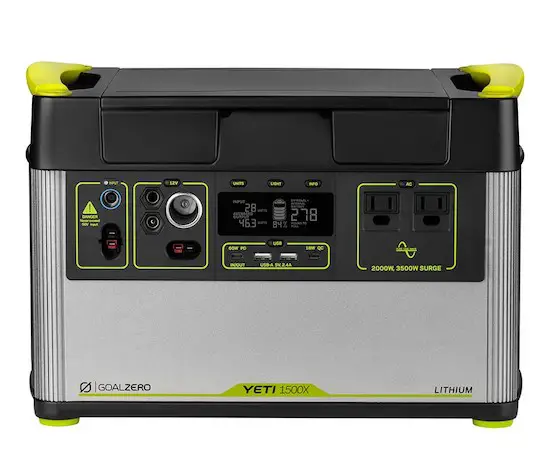I’ve analyzed and compared the several different solar generator models to find out which ones are the best for use in your car for various acvtivities.
The following are my results.
The Yeti 1500X is the best solar generator for your car because it excels in battery capacity (1,516Wh) and AC power output (2,000W continuous). It can be used for car camping, tailgating, and road trips. If you want a less expensive or smaller model, you may want a different one.
| Ranking | Model | Price |
|---|---|---|
| 1. Best for Your Car Overall | Goal Zero Yeti 1500X | Check Price on Amazon |
| 2. Best for Car Camping | Rockpals Rockpower 500 | Check Price on Amazon |
| 3. Best for Road Trips | Renogy Phoenix 300 | Check Price on Amazon |
I’ve created a table highlighting the features of each solar generator listed and what each can power below.
[table id=97 responsive=scroll /]
Before getting into the details of each solar generator, I want to break down which activities you intend to use yours for.
What Purpose Are You Using the Solar Generator for in Your Car?
There are several ways you can use a solar generator in your car, but the following are the most common:
- Car Camping
- Tailgating
- Road Trips
Car Camping
Car camping requires you to use a power bank or solar generator because you don’t want to have your car running all night while sleeping in it.
In a guide to sleeping in your car, REI lists to “keep your electronics charged” as one of the essentials for car camping. They recommend to use a solar panel or a portable battery to make this happen.
Tailgating
When at a campsite or at a sporting event, many people would like to tailgate and relax while enjoying good food, music, games, and connecting with others.
Some devices/electronics that may be used for this activity include speakers, cooking equipment, and portable refrigerators or freezers.
Road Trips
Many newer cars have USB-A ports that can charge devices. And most cars have 12V car ports to connect USB modules and other power connections.
But several don’t have AC ports, USB-C ports, or other 12V ports that may be needed for using electronics while on a road trip. This is where a solar generator can come in handy.
Similar: Can You Charge an Electric Car With a Solar Generator?
3. Renogy Phoenix 300
Best Solar Generator for Road Trips
This product is perfect if you’re planning on an overnight camping trip or a fun backyard movie night. The best thing about the Renogy Phoenix 300 is that it is very small and very easily portable.
This lightweight solar generator weighs around 6.4 pounds with dimensions of 7.1 x 6.1 x 5.6 in. This compact size makes it easy to store it away, pack it for a trip, or carry it almost anywhere.
The Phoenix 300 ranges from $289 to $399, making it an affordable option for a solar generator.
Features
The Phoenix 300 has many different outlets, including:
- (2) 110V AC outlets
- (2) USB-A ports
- (1) USB-A QC port
- (1) 60W USB-C PD port
- (1) DC car port
- (1) D-Tap port
All of these outputs make it easy to charge different devices such as phones, laptops, drone/camera batteries, and more. These devices can all be charged at the same time, or individually.
Not only does this generator have lots of charging availabilities, but it is also equipped with a multi-mode LED flashlight on both sides of the carrying handle. This flashlight can help illuminate your campsite or aid in outdoor navigation.
The solar generator creates charging convenience by providing a wall outlet, car socket, and solar panel. The Battery Management System, or BMS, has voltage temperature control, and short circuit protection with overcurrent protection.
The battery inside is lithium-ion, which guarantees long charging life. This generator also has a capacity of 337 watt-hours.
Customer Satisfaction
Customers love this product because it has great connectivity and an emergency light built-in, it is simple to recharge, and it works to recharge other devices quickly.
Downside and Drawbacks
There are a few downsides to buying this product.
Many of these may be manufacture defects that can be fixed or returned, but it’s best to be aware of potential issues ahead of time.
A main problem is that if many devices are connected, the battery will drain quickly, and have to be recharged frequently.
Another problem is that it takes 8 hours to reach full charge with this generator, and it can be frustrating to wait for it to charge fully.
Lastly, the main issue has to do with the display. Although the Phoenix 300’s display has a battery percentage indicator and port indicator (telling you which ones are in use), it does not show you how many watts are going into and out of the system.
This can be frustrating because you will not know how much input/output power you’re using with your devices or charging method.
For more information on the Renogy Phoenix 300, read my individual review on it where I explain its features, uses, and internal components in more detail: Renogy Phoenix 300 Review – A Unique Off-Grid Power Solution.
2. Rockpals Rockpower 500

Best Solar Generator for Car Camping
The Rockpower 500 is the ideal solar generator to take traveling, because it is fairly small but contains a lot of power. This generator is also the perfect generator to be used as backup power for emergencies.
Although this generator is pretty pricey, the investment is worth it, especially if you are the kind of person who likes to be prepared. The features that this generator offer makes up for the high cost.
Features
This generator has a capacity of 505 watt-hours, a high-quality pure sine wave inverter, and 120W solar input capabilities.
Not only does this generator have a lot of power, but there are also many outlets that can be used to charge a variety of devices. This device has:
- (2) AC outlets
- (2) USB-A ports
- (1) USB-A QC port
- (1) USB-C PD port
- (2) 12V DC ports
- (1) DC car port
This generator has the ability to charge an iPhone 12 fifty times, charge a small MacBook nine times, and even power a 60W projector for about seven hours.
For solar charging, the Rockpower 500 will take about 6-7 hours to recharge from a 100-120W panel. You can also combine this with the USB-C PD charging function to bring the charging time down to 4.5-5.5 hours.
The LCD display allows for super easy solar recharging, but this device can also be recharged through many other different methods, which provide great flexibility for this unit.
For more insights on the Rockpower 500, check out my complete review of this system where I test its functionality and compare it to similar models. Find it here: Rockpals Rockpower 500 Review (Testing, Pricing, and More).
Customer Satisfaction
Most customers report having a high-quality experience with Rockpals solar generators. They’ve released three solar generators in the 500Wh range, where the majority of customer reviews are positive.
Some positive aspects in particular highlight the high amount of energy that their generators provide, the flexibility in charging, and the variety of devices that they were able to charge with Rockpals systems.
Below is my video review of the Rockpower 500, where I test out its inputs and outputs to see if it can perform according to its specifications.
Downside and Drawbacks
Some of the drawbacks I noticed when testing this system include the noise its cooling fan makes when using it with high-powered devices as well as the AC charger getting hot when using it for 30 minutes or longer.
Another downside is that its battery is rated for 500 charge cycles before reaching 80% capacity.
Although this is average for most solar generators in the 500Wh category, the introduction of the LiFePO4 (lithium iron phosphate) battery to this particular solar generator would vastly improve its charge cycles and overall lifetime.
1. Goal Zero Yeti 1500X
The Overall Best Solar Generator for Your Car
The Goal Zero Yeti 1500X has ranked highest for the best overall quality for solar generators. It is ideal because it is lightweight for its size, and it can be charged through either wall outlets or solar panels.
This is the ideal generator for people who love road trips, camping, or just enjoy keeping a bit of extra power on hand. It is important to note that his generator is expensive, because of the amount of power it contains. Prices average around $1,600-$2,000 for this generator.
Features
As mentioned above, this solar generator is lightweight, especially for its size. This generator weighs 45.6 lbs, which means that it can be moved around without too much difficulty. This generator has an app called the Yeti app. When you’re connected to WiFi, this app can help you monitor the energy being used by the generator.
The 1500X stores 1,516 watt-hours in its lithium-ion battery to make it a reliable system that can run smaller devices for days.
This generator also contains 10 different output ports to power a wide range of devices.
It is recommended that one should be using 10-20% of stored energy inside the battery. If there is a consideration that power consumption will be more than 20%, it is advised to get more panels.
Customer Satisfaction
Customers have shown great satisfaction with this product. Reports compliment the reliability, large amount of power, and durability of this generator.
They also comment on how easy it is to move and to navigate. Reviews on this generator are high on many different websites. Despite the high price, this generator performs well in many different areas.
Downside and Drawbacks
The biggest customer complaint about the Goal Zero Yeti is that the Yeti company doesn’t supply replacement parts. If any part of the unit is damaged, the whole generator must be returned.
Another prominent concern is that the unit stops working in lower temperatures, which can be frustrating on camping trips where it gets chilly.
This generator contains a lot of power, but unfortunately, that means that in order to have full power, the device must be charged for a long time. It takes about 14 hours of charging from a wall outlet for this generator to reach its full charge.
This is time-consuming, and those who are planning on going on a trip should be sure to start charging their generator a few days in advance.
However, with the 1500X’s 600W solar input capability, you can charge it in as little as three hours. This can be a game-changer either when charging it up before hitting the road, or charging it while camping at your destination.
Although this unit is very powerful, there are limits to what it can power. For instance, the generator cannot power certain power tools, and it requires a reset whenever the outlet is overloaded.
For a more in-depth analysis of the Yeti 1500X, I highly recommend checking out my review of the system, where I explain what it can power as well as more key features and usability: The Yeti 1500X from Goal Zero – Overview + Comparison.
What To Look For In A Solar Generator

There is a variety of different reasons why someone might want to purchase a generator. The most common reasons are for camping or backup power in case of emergencies. Different generators will work better depending on the purpose that they are needed for.
For camping purposes, it is best to look into and use a mid-sized solar generator, such as the Rockpower 500 or the Yeti 500X. These kinds of generators have enough storage to charge devices several times over, but they still have enough power to run smaller appliances.
For tailgating, larger systems like the Yeti 1500X or the larger Point Zero Energy Titan are recommended.
These have plenty of battery life to not only charge small devices such as phones and laptops but also have enough power to run larger devices, such as portable fridges, blenders, and space heaters.
In the end, it’s the size that determines the main capabilities of each generator. Large solar generators tend to have a very high solar input which reduces their overall charging time significantly.
Mid-sized solar generators can work with solar panels at about 100 watts for a 6-9 hour charging time.
For the fastest-charging solar generator models available today, I’ve compiled and analyzed a list of them that you can find here: Top 5 Fastest Charging Solar Generators (Via AC Outlet & Solar Panels).
Basic Solar Generator Terminology
Before researching a solar generator, it is important to understand what makes that generator desirable, and that means understanding the various terminology used. Below are a few basic terms that are important to know.
BMS
BMS stands for Battery Management System. This system regulates the battery within a solar generator. The BMS allows the solar generator’s battery to be protected against various threats such as overtemperature, overvoltage, and overcurrent, among others.
The best solar generators have a BMS that will show warning signs to you via their LCD displays.
AC vs. DC
AC stands for alternating current. This means the flow of electrons changes directions back and forth at regular cycles. Power lines and normal household electricity are powered by alternating current.
DC stands for direct current. This means the electrons flow in one direction. This kind of electricity is found in a flashlight or other battery-operated appliances.
On a solar generator, there are AC and DC input and output ports that allow you to power several different devices and appliances.
| Typical Solar Generator Ports | AC or DC |
|---|---|
| Wall outlets | AC |
| USB ports | DC |
| 12V ports (such as a car port) | DC |
| Input/charging ports (wall, car, solar) | Typically DC |
Watt, Volt, Amp, Joule
A watt is a measure of the rate at which electric power is created and used. Think of it like miles-per-hour in a car; a watt will tell you how fast the electrons are moving.
According to BIPM, a volt is the “potential difference between two points of a conducting wire carrying a constant current.” It is used to determine the capacity of a system to keep a steady flow of power.
An amp, short for ampere, measures the electromagnetic force between two conductors carrying electric current.
A joule measures the work done by an object.
A good way to explain the difference between watts, volts, and amps is the age-old water analogy.
Think of a battery like a water pump, putting out energy. In this analogy, water would represent an electric charge, and the flow of the water would represent the electric current.
Voltage would be the water pressure. Amps measure current, like the volume of water flowing through a pump. Watts measure energy (amps x volts = watts), which would be the overall power the water would provide.


